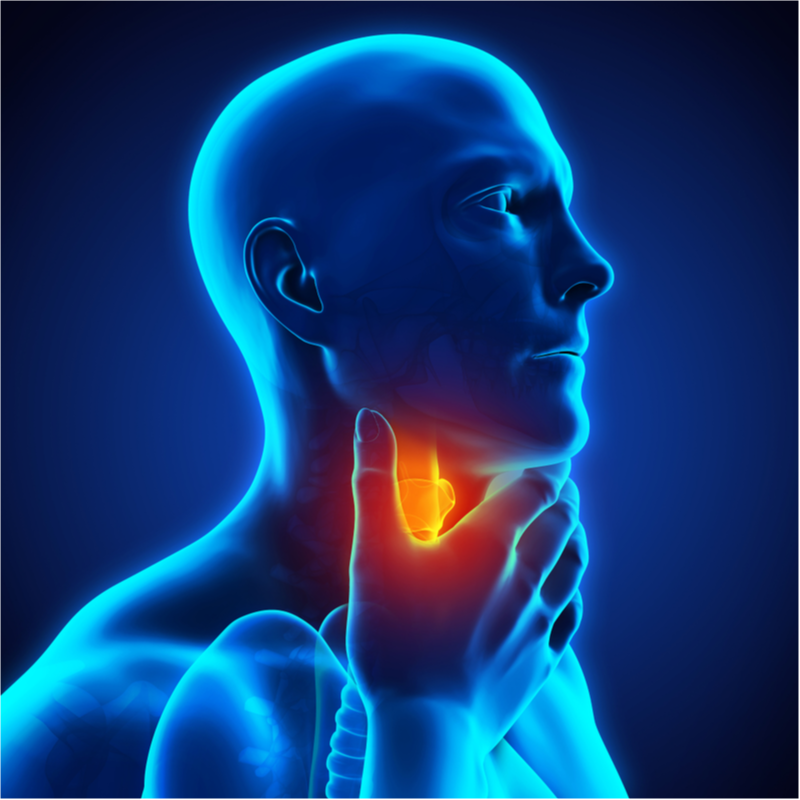
What is hypopharyngeal carcinoma?
Hyphopharyngeal carcinoma is a malignant tumour in the area of the throat, the hypopharynx. It is a form of laryngeal carcinoma. It is usually a moderately differentiated squamous cell carcinoma. In more than 95 % of cases, the tumour originates from the superficial cell layer, the squamous epithelium. A distinction is made between hypopharyngeal carcinoma and a tumour in the vocal cords, laryngeal carcinoma. However, it is often not possible to make an exact distinction. Since most of the sinus piriformis carcinomas have a submucosal spread , they mostly only represent the "tip of the iceberg". Hypopharyngeal carcinoma occurs most frequently in people between the ages of 50 and 60, with men being affected significantly more often than women.
How does hypopharyngeal carcinoma develop?
Especially Nicotine abuse and alcohol abuse, mainly in combination, favour the development of this carcinoma. However, occupational exposure to coal, tar, asbestos cement and metal acids also have a carcinogenic effect. Inadequate oral hygiene can also be a risk factor.
How often does hypopharyngeal carcinoma occur?
This carcinoma is a relatively rare disease, because only 6 % of all tumours in the head and neck area are hypopharyngeal carcinomas. For example, in 2016 there were 4,180 female and 9,720 male new cases of carcinoma of the mouth and throat in Germany. It occurs more frequently in older people and men are affected significantly more often than women, at 80 %. At the time of diagnosis, the average age is 64 years.
What are the symptoms of hypopharyngeal carcinoma?
Since there are no or only a few symptoms in the early stages of the disease, it is usually difficult to recognise the carcinoma early on. . Swelling in the throat, but without pain , is often the first sign of hypopharyngeal carcinoma. The constant feeling of having a lump in the throat and/or difficulty swallowing are also symptoms. Somewhat later, sores appear in the throat. Some patients have bloody sputum or bad breath. If the larynx is also affected, hoarseness will occur.
How is hypopharyngeal carcinoma diagnosed?
To begin, a medical history and a physical examination are carried out by a doctor. Based on this, he or she can conclude a suspicion on the basis of certain symptoms . With the help of a laryngoscopic examination of the lower throat area, the tumour can be seen in many cases . During this examination, a small tube, which is equipped with a light, is passed through the mouth or through the nose into the throat. A definitive diagnosis can only be made using a biopsy. This is then examined and evaluated in the pathology department under the microscope.
If a hypopharyngeal carcinoma is detected, further examinations of the swallowing function and the voice function are carried out. Diagnostic imaging via ultrasound, CT or MRI is necessary to determine the extent of the tumour . In order to detect distant metastases, a scintigraphy must be performed.
All the examinations described are essential for the necessary therapy and for the prognosis.
How is hypopharyngeal carcinoma treated?
A small hypopharyngeal carcinoma can be removed by laser surgery. However, it may be necessary to also remove the area of the neighbouring larynx. The primary goal of therapy is to remove the tumour completely and at the same time be able to preserve speech. The same goal naturally applies to the patient's general quality of life. Normal eating, drinking and breathing should always be maintained. However, in the case of a far advanced tumour, it is often indispensable to remove the entire larynx. If the tumour has grown into surrounding structures, such as the oesophagus or thyroid gland, parts of these will also have to be removed. However, it is almost impossible to remove the entire tumour completely , so chemotherapy and radiotherapy are often used after the operation.
If the tumour cannot be operated on, they try to get the hypopharyngeal carcinoma smaller by using a carbon dioxide laser . In the final stage, a tracheostomy and a gastrostomy are often necessary. A gastrostomy allows the patient to be fed artificially if they can no longer swallow by themselves. The tracheotomy provides access to the windpipe. This ensures that the patient is ventilated . Because hypopharyngeal carcinoma does not show any symptoms for a very long time, it is usually only discovered at a more advanced stage. In more than 50 % of those affected , the tumour is only discovered when metastases can already be seen as a swelling of the lymph nodes in the neck.
How should hypopharyngeal carcinoma be treated?
As a guideline, tumours with a low risk of recurrence should be examined every 3 months in the first year . In the second year, this is followed by intervals of 4 to 6 months, and in the third and fourth years, the follow-up examination should take place at six-month intervals. From the fifth year onwards, annual examinations are usually sufficient. If tumours pose a high risk of recurrence, follow-up examinations should take place every 6 weeks in the first year and every 3 months in the second year. In the third and fourth years, examinations should be done at six-monthly intervals and from the fifth year onwards at annual intervals.
Patients should definitely accept the offer of swallowing therapy and speech therapy after surgery. In order to be able to detect relapses and metastasis at an early stage, it is important that patients adhere to the follow-up treatment and aftercare plan.
What is the prognosis for hypopharnyx carcinoma?
For the prognosis, the size and location of the tumour is crucial. About 41 % of those affected have a survival rate of 5 years. However, age, the stage of the tumour and also nicotine and alcohol consumption are decisive factors. In the last years, the survival rate has improved significantly.
